You’re out on the lake, enjoying a beautiful day of fishing in your trusty aluminum boat. Suddenly, you notice water seeping through a small crack in the hull. Panic sets in as you realize you’re taking on more water than you can bail out. What do you do?
The first step in fixing an aluminum boat leak is finding the problem’s source. This involves thoroughly inspecting the hull, rivets, transducer screw holes, and other potential trouble spots. Once the leaks are identified, it’s time to prepare for the repair.
Preparing to repair the leak involves cleaning the affected areas, ensuring a clean and even surface for efficient patching. Remove any dirt, debris, or corrosion using sandpaper or a rotary buffer. Then, don your protective gloves and get ready to repair.
In this article, we’ll discuss how to fix an aluminum boat leak. We’ll cover everything from identifying the source of the leak to the tools and materials you’ll need for the job. So sit back, grab a coffee, and let’s get started.
Note: Are You Looking For?
What Are the Best Ways to Seal an Aluminum Boat?
If you have an aluminum boat, you know that one of the most important things you can do to protect your investment is to keep it sealed. A good seal will protect your boat from the elements and help it last longer. But what are the best ways to seal an aluminum boat?
There are a few different ways to seal an aluminum boat, but the best method depends on the specific boat and the type of sealant you use.
Some of the most common sealants for aluminum boats include polyurethane, silicone, and epoxy. Each of these has their own strengths and weaknesses, so it’s important to choose the right one for your boat.
Polyurethane
A sealant made of polyurethane is robust and resilient and can sustain heavy use. It’s a wonderful option for boats that are exposed to the elements because it is also resistant to UV rays and water.
Silicone
Another strong and long-lasting sealant is silicone, but it isn’t as UV-resistant as polyurethane. However, because it is more malleable than polyurethane, it can change size as the boat goes through the water.
Epoxy
Water and UV light resistance characterize epoxy, a particularly powerful sealer. Also incredibly hard, it can serve as a solid defense against dings and other types of harm.
Which Sealant Is Best?
The best sealant for your boat will depend on a number of factors, including the type of boat, the environment it’s in, and your personal preferences. If you’re not sure which sealant to use, talk to a professional or ask for advice at your local boat store.
How to Fix a Leak in an Aluminum Boat? Step-By-Step Guide
If you have a leak in your aluminum boat, don’t worry – it’s an easy fix. With a little time and effort, you can have your boat back in the water in no time. Here’s what you need to do:
Step 1: Finding the Leak
The first step in fixing a leak in your aluminum boat is to, of course, find the leak. This can sometimes be easier said than done, as leaks can be small and hard to spot.
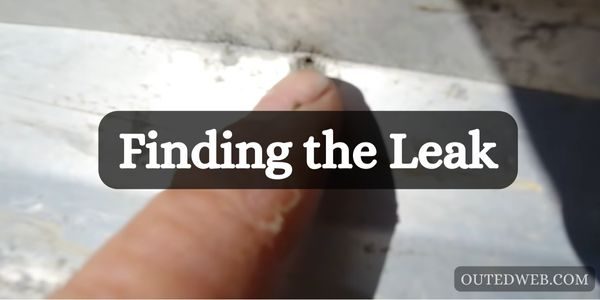
To help you find the leak, start by taking the boat out of the water and letting it dry completely. Once it is dry, inspect the hull of the boat, paying close attention to any areas that look wet or damp.
If you see any areas that are wet or damp, put a piece of tape over the area and then put the boat back in the water. Check the tape after a few minutes to see if it is wet. If it is, you have found the leak.
Step 2: Preparing to Repair the Leak
Once you have found the leak, the next step is to prepare to repair it. This includes gathering the tools and materials you will need, as well as making sure the area around the leak is clean and dry.
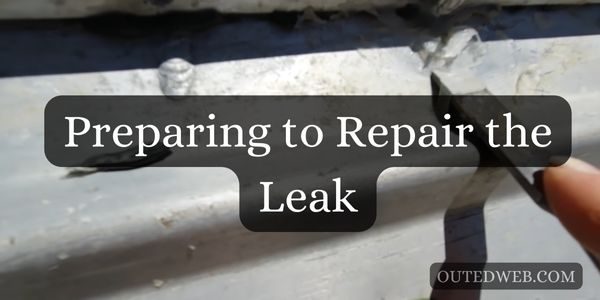
To clean the area around the leak, start by sanding away any paint or other debris that might be in the way. Once the area is clean, dry it off completely with a towel.
Step 3: Making the Repair
Now it is time to actually make the repair. There are a few different ways to do this, but the most common is to use epoxy. To use it, start by mixing together the epoxy resin and hardener according to the instructions on the package.
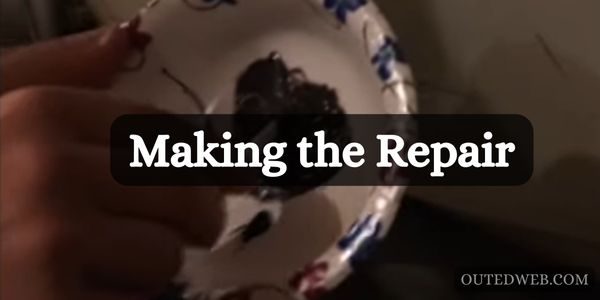
Once the epoxy is mixed, apply it to the leak using a putty knife or another tool. Next, spread the epoxy evenly over the leak, making sure to fill in any cracks or holes.
Step 4: Finishing Up

After the epoxy has been applied, the final step is to finish up the repair. This includes letting the epoxy dry and then sanding the area smooth. Once the epoxy is dry, you can paint over it if you want, or you can leave it as is.
What to Use to Fill Holes in Aluminum?
If you’re working with aluminum and you need to fill a hole, there are a few different options you can choose from. Each has its own set of pros and cons, so it’s essential to select the right one for the job at hand.
Aluminum Filler Rods
One option for filling holes in aluminum is to use aluminum filler rods. These are specifically designed for welding aluminum, so they’re a good choice if you’re planning on welding over the hole after filling it. Aluminum filler rods are also relatively easy to find and relatively inexpensive.
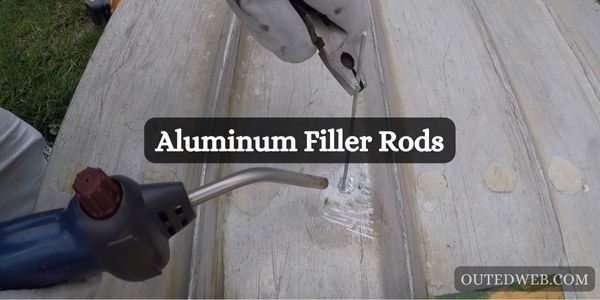
The downside of using aluminum filler rods is that they can be difficult to work with. They have a tendency to snap and break easily, so it’s important to be careful when using them. They also don’t always produce a very smooth finish.
Tin Filler Rods
Another option for filling holes in aluminum is to use tin filler rods. These rods are similar to aluminum filler rods, but they’re made of tin instead of aluminum.
The advantage of using tin filler rods is that they’re a bit easier to work with than aluminum filler rods. They’re also less likely to break, and they produce a smoother finish.
The downside of tin filler rods is that they’re more expensive than aluminum filler rods. They’re also not as widely available, so you may have to order them online or from a specialty store.
Lead Filler Rods
If you’re looking for the strongest possible filler for holes in aluminum, lead filler rods are a good option. Lead filler rods are made of lead, so they’re very strong and durable. They’re also easy to work with, and they produce a smooth finish.
The downside of lead filler rods is that they’re very heavy, so they can be difficult to use. They’re also poisonous, so it’s important to take precautions when using them. These rods are also more expensive than other options.
Aluminum Tape
This is a good option if you’re looking for an easy and inexpensive way to fill holes in aluminum. It is made of thin aluminum foil, and it’s self-adhesive. So all you need to do is cut a piece of tape to size and stick it over the hole.
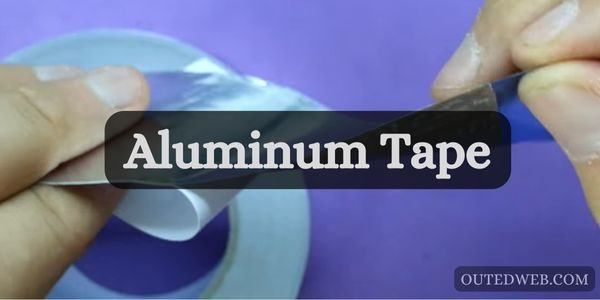
The advantage of using aluminum tape is that it’s very easy to use. It’s also inexpensive, and it produces a smooth finish. The downside of using aluminum tape is that it’s not very strong. It’s also not very durable, so it won’t last as long as some of the other options.
Welding
Filling holes in aluminum with welding is another alternative. Although it is a more labor-intensive method of patching holes, it is also sturdy and long-lasting. It is advised to leave this choice to a professional if you have no prior welding experience.

The advantage of welding is that it’s very strong and it produces a smooth finish. The downside of welding is that it’s difficult to do, and it can be dangerous.
What to Consider When Choosing a Sealant for Your Aluminum Boat?
Here are a few things to consider when choosing a sealant for your aluminum boat:
Ease of Use
You want a sealant that is easy to apply, so you can get the job done quickly and without any hassle.
Durability
A good sealant should be durable and long-lasting, so you don’t have to worry about reapplying it every few months.
Flexibility
Flexibility is essential in a sealant because it helps the sealant adhere to the aluminum better and prevents cracking.
UV Resistance
You want a sealant that will resist fading and peeling from exposure to the sun.
Environmental Friendliness
If you’re concerned about the environment, you may want to choose a sealant that is low in VOCs (volatile organic compounds).
Top 5 Sealants for Aluminum Boats
Here are a few of the best sealants for aluminum boats:
3M Marine Grade Silicone Sealant
This is a versatile sealant that can be used on a variety of materials, including aluminum. It forms a strong bond that is resistant to weathering and wear.
DICOR Butyl Tape
Easy to use and offers a reliable, flexible seal, DICOR Butyl tape is a great choice. In addition, it is UV-resistant and environmentally safe.
PERMATEX PERMAPOXY 4 Minute Multi-Surface Epoxy
Aluminum, glass, metal, plastic, and wood can all be coated with this two-part epoxy, which sets in only four minutes. It is waterproof and suitable for usage both inside and outside.
Loctite Pl Marine Epoxy
On wet or dry surfaces, this two-part epoxy creates a strong bond that lasts. As a result, extreme heat, sunlight, and water are not damaging to it.
3M 5200 Marine Adhesive/Sealant
One of the most widely used sealants for aluminum boats is this one. It is a long-lasting, waterproof sealer that creates a solid bond. Additionally, it is UV-resistant and won’t fade or yellow over time.
Aluminum Boat Leak Prevention Tips
It’s no secret that aluminum boats are susceptible to leaks. But there are some things you can do to prevent leaks from happening in the first place. Here are some tips:
Check for Cracks And Holes Regularly
It’s important to check your boat for cracks and holes on a regular basis. You can use a flashlight to help you spot them easily. If you find any, patch them up immediately with a repair kit.
Inspect the Seams And Caulking
The seams and caulking of your boat should also be inspected regularly. Look for any cracks or gaps and seal them up with a good quality caulking.
Use a Tarp When Not in Use
When you’re not using your boat, it’s a good idea to cover it with a tarp. This will help protect it from the elements and prevent any leaks.
Store It Properly
When you’re not using your boat, be sure to store it in a dry, safe place. This will help prevent any leaks or other damage.
Check the Hull Regularly
Your boat’s hull should be checked regularly for any cracks or leaks. If you find any, patch them up immediately.
Don’t Forget About the Bilge
The bilge is another area of your boat that is susceptible to leaks. Be sure to check it regularly and empty it out if necessary.
Keep an Eye on the Weather
Bad weather can cause serious damage to your boat, so it’s important to keep an eye on the forecast. If a storm is brewing, take steps to protect your boat and prevent any leaks.
Have a Plan for Emergencies
If you do happen to get a leak, it’s essential to have a plan for dealing with it. Be sure to have a repair kit on hand and know how to use it. You should also have a list of emergency numbers handy in case you need to call for help.
Following these tips will help you prevent any leaks in your boat and keep it in good condition. Be sure to check it regularly and take steps to protect it from the elements.
Final Say
In conclusion, to fix a leak in an aluminum boat, you will need to use a sealant specifically designed for aluminum boats. There are many different sealants available on the market, so it is essential to consider your options carefully before making a decision.
You should also take into account the size and location of the leak when choosing a sealant. Finally, be sure to follow the manufacturer’s instructions carefully when applying the sealant to your boat.

